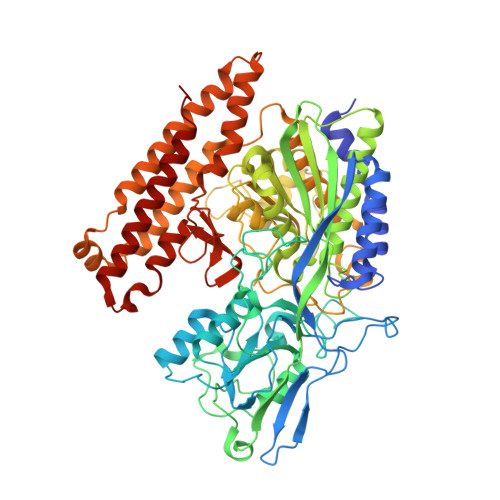Structural and computational basis for potent inhibition of glutamate carboxypeptidase II by carbamate-based inhibitors.
Barinka, C., Novakova, Z., Hin, N., Bim, D., Ferraris, D.V., Duvall, B., Kabarriti, G., Tsukamoto, R., Budesinsky, M., Motlova, L., Rojas, C., Slusher, B.S., Rokob, T.A., Rulisek, L., Tsukamoto, T.(2019) Bioorg Med Chem 27: 255-264
- PubMed: 30552009
- DOI: https://doi.org/10.1016/j.bmc.2018.11.022
- Primary Citation of Related Structures:
6ETY, 6EZ9, 6F5L, 6FE5 - PubMed Abstract:
A series of carbamate-based inhibitors of glutamate carboxypeptidase II (GCPII) were designed and synthesized using ZJ-43, N-[[[(1S)-1-carboxy-3-methylbutyl]amino]carbonyl]-l-glutamic acid, as a molecular template in order to better understand the impact of replacing one of the two nitrogen atoms in the urea-based GCPII inhibitor with an oxygen atom. Compound 7 containing a C-terminal 2-oxypentanedioic acid was more potent than compound 5 containing a C-terminal glutamic acid (2-aminopentanedioic acid) despite GCPII's preference for peptides containing an N-terminal glutamate as substrates. Subsequent crystallographic analysis revealed that ZJ-43 and its two carbamate analogs 5 and 7 with the same (S,S)-stereochemical configuration adopt a nearly identical binding mode while (R,S)-carbamate analog 8 containing a d-leucine forms a less extensive hydrogen bonding network. QM and QM/MM calculations have identified no specific interactions in the GCPII active site that would distinguish ZJ-43 from compounds 5 and 7 and attributed the higher potency of ZJ-43 and compound 7 to the free energy changes associated with the transfer of the ligand from bulk solvent to the protein active site as a result of the lower ligand strain energy and solvation/desolvation energy. Our findings underscore a broader range of factors that need to be taken into account in predicting ligand-protein binding affinity. These insights should be of particular importance in future efforts to design and develop GCPII inhibitors for optimal inhibitory potency.
Organizational Affiliation:
Institute of Biotechnology of the Czech Academy of Sciences, BIOCEV, Prumyslova 595, 252 50 Vestec, Czech Republic. Electronic address: cyril.barinka@ibt.cas.cz.






















